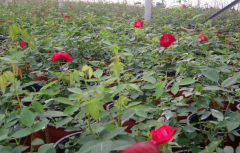Is it easy to plant evergreen trees? how to plant them? When is it better to transplant? what are the points for attention?
Evergreen is a popular way to plant trees, so is it easy to grow? How to plant it, and what matters should be paid attention to in the process of planting? Let's have a look!
The best time to plant evergreen
Evergreens can be planted at any time that suits you, but sometimes they are better than others. The absolute best time to plant evergreen conifers is in early spring, when the soil thaws and frosts. Evergreens will be built in cool weather and a lot of spring rain. As long as you make sure they get enough water, growing evergreens can last until spring.
Early autumn is also a good time to plant evergreen conifers, which take at least six or eight weeks before the soil begins to freeze. Before experiencing the heat of summer, evergreens will mature in autumn and early spring, and the plant is harder than winter. Be sure to water deeply every week until the ground freezes and covers heavily to prevent ups and downs during the freeze / thaw cycle.
In hot summers, even established evergreens are often under pressure. Newly planted evergreens have experienced transplant shock and worked very hard to establish roots, so heat and drought will make it harder for plants to stay healthy and strong.

Prepare planting holes for your evergreens
Preparing the implant hole is your top priority. Dig holes as deeply as possible to make the soil loose enough and make the roots easy to stretch. Evergreens usually have shallow roots, so they are at least 2 to 4 times the width of the root ball, and at least a foot deep, a few inches deeper than the root ball.
If you choose evergreens and soil types that grow well locally, you don't have to modify or enrich the soil. If you dig a beautiful hole and fill it with beautiful and fertile soil, the roots will usually find it difficult to transition from the hole to through the native soil. When a good storm comes, you may be surprised to see a complete piece of fertile soil pulled up from the roots on the evergreen trees on the ground. Having said that, if your soil is very poor or unsuitable for trees, you may need to do something to modify the soil. Your hole should be much larger to provide a lot of space for the roots and use as little modified soil as possible to improve the soil. Evergreens should drain well, but keep the soil moist. If your soil is sandy, mixing one or two buckets of compost in the soil will help the soil retain moisture. If the soil is heavy clay, a similar amount of broken leaves or peat moss will help drain the soil. Even evergreens are well adapted, so don't make them too comfortable in rich holes, just a little improvement can help the tree adjust to your conditions. It certainly will not make the hole so rich that water will not flow from the hole into the surrounding soil.
Plant evergreen
When the hole is ready, put the container into the hole and check the depth of the hole. Adjust and gently tamp the soil level so that the top of the root ball is flush with the surrounding soil level. Restore the soil you dug into a hole, smooth and gently fix the soil. Water the soil until it is fully soaked. When the soil settles, you may find that the root ball is slightly lower. Grasp the base of the torso and gently pull upward until the root ball is flush with the soil surface again. Continue watering, filling and adjusting the level of the root ball until the soil settles evenly. Don't let the root ball settle and fill the trunk with soil. If the evergreen plants are planted too deep, the trees may die out as soon as possible.
Cover 2 to 4 inches thick, a few inches wider than the widest part of the plant. Do not use the trunk to contact the trunk, leave a gap of one or two inches on the trunk. The best mulch for evergreen plants is wood or bark mulch, rough pruning or rough composting. Mulch is very important, helps keep the roots moist, and becomes more important in winter. If winter dryness can be prevented, evergreen plants will absorb water from the soil throughout the winter. Mulch will help the soil retain moisture and help prevent the soil from freezing deeply.
Poor soil drainage, deep planting and winter dryness are the most common causes of damage or death of acupuncture evergreen trees. They can be easily killed by standing at the root of the water. They must be planted in well-drained soil.
In the coldest climates, make sure that the root balls are planted at or even slightly below the surrounding soil level and are heavily covered. This will help isolate the roots in winter and help prevent ups and downs during freezing and thawing. If you plant a little deeper, your soil drainage is very important.
The thickest clay soil needs a good soil hole to improve soil conditions and improve drainage. In warmer areas with heavy clay, root balls can be surrounded and planted above the level of the surrounding soil to avoid poor drainage.
Pay attention to the newly planted evergreen trees
Just make sure there is enough water to promote good root development. Soak the evergreen tree slowly every week by moving a slow dripping hose around the root ball for a few hours. The aim is to soak the root ball and the wide area around the implant hole to encourage the root to move out of the hole.
Newly planted evergreens may experience transplant shock. The leaves may turn yellow and the needles may fall. Don't worry about this in the first or second month, it's a natural reaction as it tries to build itself. Don't drink too much water, don't fertilize, it will only make the situation worse. Adapt the plants to the new conditions of the first season.
Even for mature evergreens, fertilization is usually not required. Do not mix fertilizer into the planting hole to prevent root damage. Most conifers don't need fertilizer at all. Evergreens that become tense due to winter drought, poor soil and damaged diseases or insects may benefit from light feeding in the spring. Some varieties may prefer light feeding in the first few seasons before taking it in the spring. Follow the instructions of individual varieties, but it is usually sufficient to gently sprinkle balanced granular fertilizer in early spring. Fertilizers for evergreens also improve soil acidity and help keep needles green. Please carefully follow the fertilizer packaging instructions to apply.
It is common to die in cold climates in winter, especially for newly planted evergreens that are not yet mature. You can wrap your young evergreen in burlap or erect a sunscreen / windscreen in the first or second year to protect it.
- Prev

How to grow tomatoes? What is the planting method and time of tomatoes? when?
Tomato is a common vegetable, and it is also very popular in the market. Do you know how to grow tomatoes? When are tomatoes available? Let's have a look! Tomato planting method and time: tomatoes are usually planted in
- Next

What are the methods and techniques of planting roses? What are the conditions for planting roses? what kind of soil do you need?
The cold winter makes it difficult to grow beautiful roses in the northern and Midwestern gardens. A limited number of varieties can survive on their own, and many need winter protection. Many rose bushes even need protection, even in relatively mild winters (up to Zone 6 or
Related
- A course of planting techniques and methods on how to grow carrots
- How to plant the latest tulips?
- Is it better to pick tea in the morning or in the afternoon? When is the best time for tea to be picked? what is the third or fifth tea?
- Launch Yuanxiao Happy combination Haocha + Tea Yuan healthy Taste
- Penghu Tourism "Fireworks 20 Parade with You"
- 2022 West Lake Happiness holds "Digital Revitalization Voucher" and draws iphone13 and laptop.
- Banqiao Fuzhou social houses are designed to change start-up combined with police elimination to create a safe and livable environment
- The convenient measure of "mechanical weeding" in Xinbei has been abused and the Agriculture Bureau has imposed heavy penalties on the illegal land consolidation.
- Changgeng University Joins Hands with Four Memory Factories to Rescue Memory Talent Shortage
- The list of Taiwan's top 100 MVP managers is listed by the Director-General of the Farmers' Association of Sanxia District.

